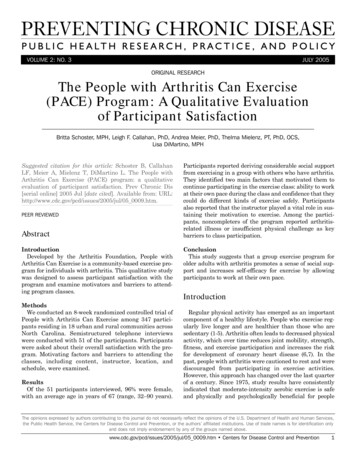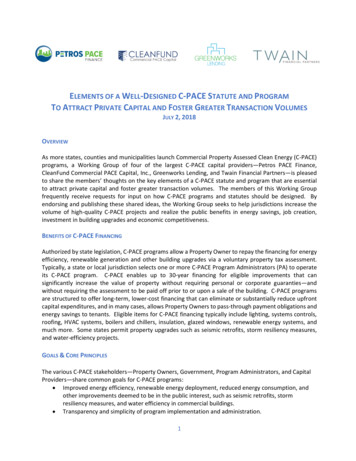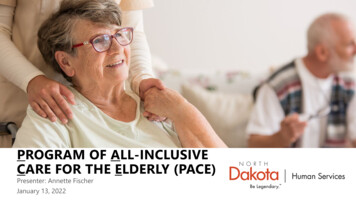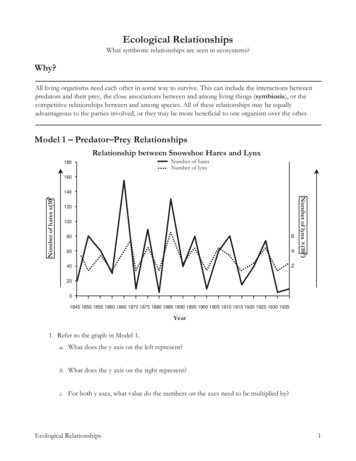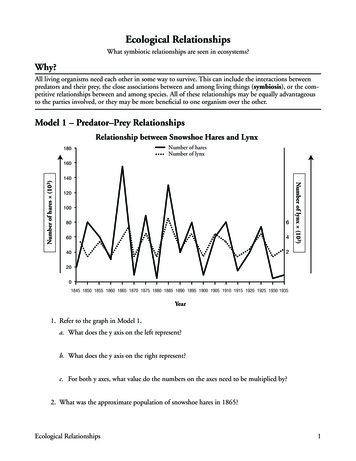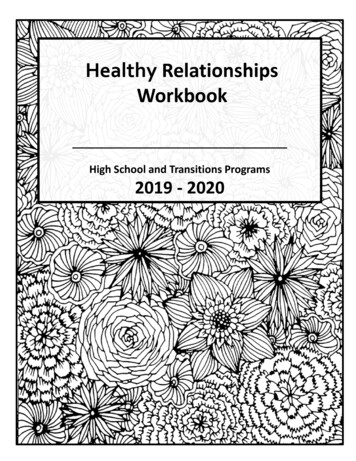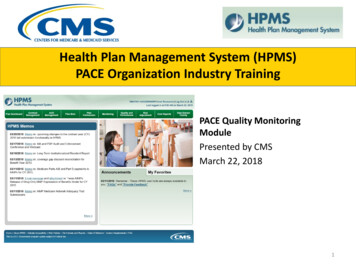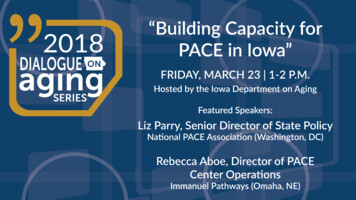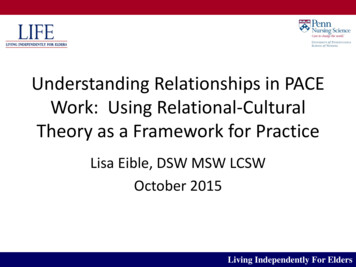
Transcription
Understanding Relationships in PACEWork: Using Relational-CulturalTheory as a Framework for PracticeLisa Eible, DSW MSW LCSWOctober 2015Living Independently For Elders
Learning Objectives Participants will develop a basicunderstanding of Relational Cultural Theory. Participants will understand the relationshipbetween attachment theory and RCT. Participants will develop an understanding ofRelational Cultural Therapy and it’sapplications to practice. Participants will demonstrate understandingof course content through discussion.Living Independently For Elders
Overview Part One: Theoretical Background andOverview Part Two: Focus on Culture and Diversity Part Three: Relational-Cultural Practice andPACE ParticipantsLiving Independently For Elders
Part OneTheoretical Background andOverviewLiving Independently For Elders
What is Theory?Living Independently For Elders
Discussion Do you have a theoretical approach,philosophy, mantra, proverb, or other type ofdogma/belief/code which guides yourpractice?Living Independently For Elders
Background Developed by women at the Stone Center atWellesley College Initially called Self-in-Relation theory Traditional developmental theories prioritizeindependence and separation from othersLiving Independently For Elders
Relational-Cultural Theory Connection is the “primary organizer and sourceof motivation in people’s lives” (Complexity ofConnection, Jordan and Walker, 2004, p 1) Connection is the core of human growth anddevelopment. Isolation is the primary source of humansuffering. Human beings grow through and towardconnection.Living Independently For Elders
Attachment Theory as a FoundationLiving Independently For Elders
Attachment TheoryHarlow and experiments with monkeys (6minutes)http://www.youtube.com/watch?v OrNBEhzjg8IDescription of Attachment Impact (5 minutes)http://www.youtube.com/watch?v 6bul1meciGELiving Independently For Elders
Attachment TheoryRene Spitz (1952) (7 minutes)http://www.youtube.com/watch?v VvdOe10vrs4Living Independently For Elders
Tenants of Relational Cultural Theory Traditional models do not matchwomen’s/human experience. The goal of development is to become in engagedin growth-fostering relationships. Relatedness and connectedness are criticalcomponents to healthy development. The value of relationships is often minimized intraditional theories, and women are made to feelashamed of efforts/focus on emotionalconnections.Living Independently For Elders
Definitions ConnectionAlthough this term is used in common parlance tomean any kind of relationship, RCT defines connectionas an interaction between two or more people that ismutually empathic and mutually empowering. DisconnectionsInteractions in relationships where mutual empathyand mutual empowerment do not occur; usuallyinvolves disappointment, a sense of beingmisunderstood, and sometimes a sense of danger,violation, and/or impasse. Disconnections may beacute, chronic, or traumaticSource: cultural-therapy#connectionLiving Independently For Elders
Definitions Mutual EmpathyOpenness to being affected by and affecting anotherperson. In mutual empathy, both people move with asense of mutual respect, an intention for mutualgrowth, and an increasing capacity for connectedness.For mutual empathy to lead to growth, both peoplemust see, know, and feel that they are being respondedto, having an impact, and mattering to one another.The growth that occurs is both affective and cognitiveand leads to an enlarged sense of community.Supported vulnerability, a feeling that one'svulnerability will not be taken advantage of or violated,is necessary for mutual empathy.Source: cultural-therapy#connectionLiving Independently For Elders
Connection and Vulnerability http://www.ted.com/talks/brene brown onvulnerability(3 minutes – 10 minutes)Living Independently For Elders
Definitions, continued Authenticity: The capacity to fully representoneself in a relationship; to bring one’s realexperiences, thoughts, and feelings into therelationship. Relational Images: The collection of ideas andexperiences we have about relationships,based on past relationships. Shame: When one feels that he/she is nolonger worthy of empathy or love.Source: (Molly Henchman, 2005-2006, Jean Baker Miller Institute, 2011)Living Independently For Elders
Core Concepts of RCT1. People grow through and toward relationshipin the life span.2. Movement toward mutuality rather thanseparation characterizes mature functioning3. Relationship differentiation and elaborationcharacterize growth.4. Mutual empathy and mutual empowermentare at the core of growth-fosteringrelationships.Living Independently For Elders
Core Concepts of RCT5. Authenticity if necessary for real engagementand full participation in growth fosteringrelationships.6. In growth fostering relationships, all peoplecontribute and grow or benefit. Development isnot a one way street.7. One of the goals of development from arelational perspective is the development ofincreased relational competence and capacitiesover the life span.Source: “Relational-Cultural Therapy, Jordan, 2010Living Independently For Elders
Cycle of yConnectionLiving Independently For Elders
Cycle of DisconnectionOpportunity for ConnectionChronic iving Independently For Elders
Cycles of Relational ctionLiving Independently For Elders
The “Five Good Things”Miller noted five good things that come from connected,growth-producing relationships: a sense of zest that comes from connecting withanother person; the ability and motivation to take action in therelationship, as well as in other situations; increased knowledge of oneself and the other person; an increased sense of worth; and a desire for more connections beyond the particularone (Miller, 1988).Living Independently For Elders
Relational-Cultural Theory “When we are hurt, misunderstood, or violated insome way, when we attempt to represent ourexperience to the injuring person and we are notresponded to, we learn to suppress our experience anddisconnect from both our feelings and the otherperson.” (p2) “If on the other hand, we are able to express ourfeelings and the other person responds with care,showing that we have had an effect, then we feel weare effective in relationship with others, that wematter, that we can participate in growth-producingand healthy relationships” (p2)Living Independently For Elders
RCT as Evidence Based “hardwired to connect” Functional MRIs are showing– how positive and negative relational featuresimpact the brain– Possibility of repairLiving Independently For Elders
Part TwoFocus on Culture and DiversityLiving Independently For Elders
Relational Images Relational Images: The collection of ideas andexperiences we have about relationships,based on past relationships.Living Independently For Elders
Discussion What are the similarities and differencesbetween racism and relational images?Living Independently For Elders
DiscussionGrowing up, what were the predominantmessages you received about culturaldifferences? What did you observe from theadults in your life about how to "handle"difference?Living Independently For Elders
Focus on Culture and Diversity Relational ImagesCultural PrivilegeConcepts of PowerCross-Cultural ConnectionLiving Independently For Elders
Definitions PowerMost fundamentally, the "capacity to produce a change"(Miller, 1968, p.198). Power OverA concept in many societies that people can only feel safe andproductive if they exercise power over others, keeping theothers in a less advantaged position. The dominant groupexercises power over other groups and individuals and doesnot encourage mutually empowering relationships. Thismodel leads to disconnections and violations of relationships.Source: cultural-therapy#powerLiving Independently For Elders
PrivilegePrivilegeA system of advantage gained through another'sdisadvantage (McIntosh, 1980, 1988). Unearned privilege isaccrued through an accident of birth or luck, being part of aprivileged group. The myth of meritocracy sometimes makesit seem as if the advantage or privilege has been earned.,198rned privilege is accrued through an accident of birth orluck, being part of a privileged group. The myth ofmeritocracy sometimes makes it seem privilege has beenearned. For example, white privilege is "an invisible packageof unearned assets that [a white n] can count on cashing ineach day but about which [he or she] was 'meant' to remainoblivious" (McIntosh, 1988).Source: cultural-therapy#powerLiving Independently For Elders
Activity Walk of PrivilegeLiving Independently For Elders
Discussion What "unearned privileges" do youhold? Describe a situation where yourunearned privilege has benefitted you.Living Independently For Elders
Implications of Cultural Privilege What is cultural privilege? How is cultural privilege distorted? Cultural privilege implications– Those with cultural privilege can appear more selfsufficient, more healthy, more worthy of privilege– Those who have less cultural privilege can beviewed as deficient and needy.Living Independently For Elders
Understanding PrivilegePrivilege areyou?utm term .roJ0wdBv7#.wqzDnNQ0ALiving Independently For Elders
Authenticity When we can’t be authentic, when our realexperience is not heard by others, we– falsify, detach or suppress our response.– Develop strategies of disconnection– Expect a relationship that is not mutual.Living Independently For Elders
Race and Connection Desire for cross-cultural connection isimpacted by– Larger cultural context that does not supportmutuality– Conflict, including the growth that results fromconflict– Need to “stretch” across differencesLiving Independently For Elders
Relational Images and Possibilities “We sometimes get rutted in disconnectionsbecause the possibility of connection doesbring with it vulnerability – the challenge tolet go of the relational images that seem toprovide a protective function”(Walker in Miller &Walker, 141)Living Independently For Elders
Definitions Racial Identity DevelopmentDefined by Tatum (1993) as "a process of movingfrom internalized racism to a position ofempowerment based on a positively affirmedsense of racial identity" (p. 3). RacismDefined by Tatum (1993) as "a pervasive systemof advantage based on race which has personal,cultural and institutional implications for ourdaily lives" (p. 2).Living Independently For Elders
Racial Identity Development Social identities Awareness of multiple social identities– Need to form alliances where people are targetedand disadvantaged– Taking responsibility for group privilege– Concepts of being “in the center” and “in themargin” Choices related to moving in one direction or anotherLiving Independently For Elders
Race and Connection Social segregation– Work is a location where cross-racial contactoccurs– Conflict is inevitable– Importance of “home communities”Living Independently For Elders
Race and Connection Staying Open in Cross-Cultural Connection– Listen undefensively– Be conscious– Recognize the journey and processLiving Independently For Elders
Discussion What examples are there are successful crossracial relationships? In media, in the workingenvironment, in your personal experience? How were you prepared, or not, to work crossracially and/or cross culturally? What are the barriers for you (self awareness)in working cross-racially and/or crossculturally?Living Independently For Elders
Relational Images and Possibilities “Typically what we get in much so-calleddiversity training is that the people thatinhabit the more powerful categories need tobehave better. That’s certainly true. However,relational-cultural healing is also about howeverybody needs to be open to movement. “(Walker in Miller &Walker, 141)Living Independently For Elders
Part ThreeRelational-Cultural Practiceand PACE ParticipantsLiving Independently For Elders
DiscussionHow might RCT apply to your work with PACEparticipants?Living Independently For Elders
Application of RCT to PACE Focus on healing, growth producingrelationships. Relational commitment. Focus on quality of life. Development of “5 good things” . Ability to reconnect, to continue relationshipdespite disconnection or conflict.Living Independently For Elders
Application of RCT to PACE Multiple layers of healing opportunity.Opportunity to work cross-culturally.Focus on diversity issues.Consideration of issues of privilege in worktogether. Opportunity to work through vulnerabilities. Opportunity for authenticity.Living Independently For Elders
Citations Jordan, J. V., Hartling, L. M., & Walker, M. (Eds.). (2004).The complexity of connection: Writings from the StoneCenter's Jean Baker Miller Training Institute. GuilfordPress. http://www.jbmti.org Jordon, J. V. (1997). Women's Growth in Diversity. Jordon, J., Kaplan, A. G., Miller, J. B., Stiver, I. P., &Surrey, J. L. (1991). Women's growth in connection. Jordan, J. V. (2009). Relational-cultural therapy.American Psychological Association. McGoldrick, M., Giordano, J., & Garcia-Preto, N. (Eds.).(2005). Ethnicity and family therapy. Guilford Press.Living Independently For Elders
Citations Miller, J. B. (2012). Toward a new psychologyof women. Beacon Press. Miller, J. B. (2015). The healing connection:How women form relationships in therapy andin life. Beacon Press. Miller, J. B., & Stiver, I. P. (1997). The healingconnection.Living Independently For Elders
Living Independently For Elders Learning Objectives Participants will develop a basic understanding of Relational Cultural Theory. Participants will understand the relationship



